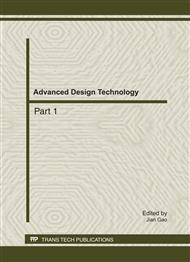[1]
Malin V Y.: Welding Journal, Vol. 62, (1983) pp.22-30.
Google Scholar
[2]
Hori Katsuyosi, Haneda Mitsuaki.: Journal of the Japan Welding Society, Vol. 68, (1999) pp.41-59.
Google Scholar
[3]
Fuju Zhang, Chuanhong Luo: Welding Technology (in Chinese), Vol. 29, (2000) pp.33-36.
Google Scholar
[4]
Nazarchuk, A. T, Sterenbogen, Y. A.: Automatic welding, Vol. 37, (1984) pp.54-58.
Google Scholar
[5]
Fuju Zhang, Chuanhong Luo: Welding Technology (in Chinese), Vol. 31, (2002) pp.8-10.
Google Scholar
[6]
Chunli Yang, Sanbao Ling: Arc Welding Foundation (in Chinese), Harbin Institute of Technology press (Harbin), (2003) pp.85-88.
Google Scholar
[7]
Bo Zhao, Chenglei Fan, Chunli Yang: Welding (in Chinese), No. 2, (2008) pp.11-14.
Google Scholar
[8]
Fangming Zhou, Zhishui Yu, Yu Wang et al.: Mechanical Engineering (in Chinese), Vol. 40, (2004) pp.58-61.
Google Scholar
[9]
K. Kobayashi, Y. Nishimura, T. Iijima, et al.: Proc. IIW Annual Meeting Bucharest 2003, Bucharest, Romania, July 6–11, 2003, IIW Doc.XII-1766-03 (2003).
DOI: 10.1007/bf03266389
Google Scholar
[10]
K. Kobayashi, M. Yuki, A. Tejima, et al.: Ishikawajima-Harima Eng. Rev., Vol.42, (2002) pp.127-132.
Google Scholar
[11]
K. Kobayashi, M. Yamada, K. Fujishima, et al.: Proc. IIW 2001 Annual Meeting Ljubljana 2001, Ljubljana, Slovenia, July 8-12, 2001, IIW-Doc.XII-1669-01 (2001).
Google Scholar
[12]
Hidekazu ASANO, Shuusuke SAWA, Masanori ARITOM: NUCLENCE SCIENCE and TECHNOLOGY.,Vol. 42, (2005) pp.573-587.
Google Scholar
[13]
Zheng Sun, Min Kuo, Dayou Pan: SIMTech Technical Report (Joining Technology Group, Process Technology Division, 1999).
Google Scholar
[14]
Lassaline.E, Zajaczkowski.B, North.T.H: Welding Journal, Vol. 68, (1989) pp.53-58.
Google Scholar
[15]
Rongshi Xiao, Shikai Wu: Chinese laser (in Chinese), Vol. 35, (2008) pp.1680-1685.
Google Scholar
[16]
CHEN Yan-bin, MIAO Yu-gang, LI Li-qun, et al.: Transactions of Nonferrous Metals Society of China, Vol. 19,(2009) pp.26-31.
Google Scholar
[17]
Shangyang Lin, Zhen Lei, Xuyou Wang et al.: A laser-arc compounding narrow-gap precision welding method (in Chinese), patent No. 200810222139.5, (China, 2009).
Google Scholar
[18]
Rongshi Xiao, Shikai Wu, Weixiong Yang et al.: A narrow-gap laser-arc compounding welding method of using filler wire (in Chinese), patent No. 200910077011.9, (China, 2009).
Google Scholar
[19]
Cook.G.E, Levick P.C. : Welding Journal, Vol. 64 (1985) pp.27-31.
Google Scholar
[20]
Brown D C et al.: Welding Journal, Vol.41 (1962) pp.241-250.
Google Scholar
[21]
Tseng C F, Savage W F.: Welding Journal, Vol. 50 (1971) pp.777-785.
Google Scholar
[22]
Aijun Hua, Shujun Chen, Shuyan Ying: Welding Technology (in Chinese), Vol. 29(2008) pp.5-8.
Google Scholar
[23]
Shujun Cheng, Xuezhen Wang, Aibing Hua et al.: Welding Machine (in Chinese), Vol.36 (2006) pp.47-50.
Google Scholar
[24]
Shujun Chen, Shuyan Ying, Jun Wang et al., The magnetic controlled large current MAG welding methods and equipments used for deep groove (in Chinese), patent No. 200410086897.0,(China,2007).
Google Scholar
[25]
P.J. Modenesi: Research Project, Department of Metallurgical Engineer, Belo Horizonte, UFMG, (1986) p.14.
Google Scholar
[26]
Cicero M.D. Starling, Paulo V. Marques, Paulo J. Modenesi.: Journal of Material Processing Technology, Vol.51 (1995) pp.37-49.
Google Scholar
[27]
V.Yu.Belous, V.P. Prilutsky, V.N. Zamkov: Scientific and Technical, No.4, (2004) pp.11-14.
Google Scholar
[28]
V.Yu.Belous, S.V. Akhonin: Scientific and Technical, No.4, (2007) pp.2-5.
Google Scholar
[29]
Shaoxian Zheng: The research on the technology of ultra-narrow-gap gap welding with the flux strips constricting arc (in Chinese), Lanzhou University of Science and Technology (Lanzhou, 2007) pp.9-12.
Google Scholar
[30]
Renjun Zhang: The study of ultra-narrow-gap gap welding technology with constricted TIG arc by two pieces of rotary ceramics (in Chinese), Lanzhou University of Science and Technology (Lanzhou, 2007) pp.29-30.
Google Scholar
[31]
Yuji Tian: The characteristic of TIG arc and the application of ultra-narrow-gap welding technology with constricted TIG arc by two pieces of solid (in Chinese), Lanzhou University of Science and Technology (Lanzhou, 2008) pp.19-45.
Google Scholar
[32]
B.J. Corlett, J.Lucas, J.S. Smith: IEE Proceedings-A, (1991) pp.213-222.
Google Scholar


